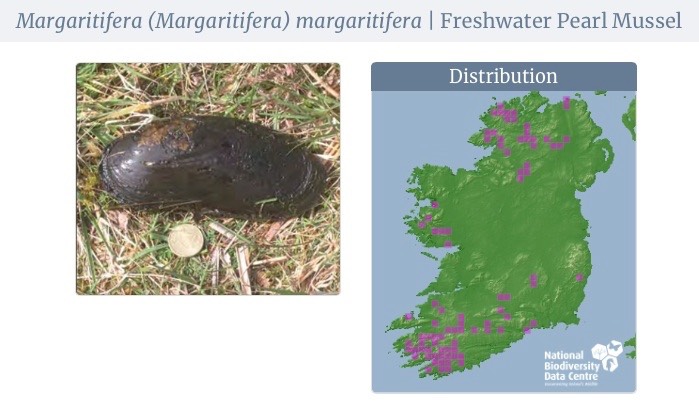 The freshwater pearl mussel (Margaritifera margaritifera) is a large filter-feeding bivalve, which is found in near-pristine freshwater habitats. Just like all bivalve molluscs, it has a shell with two halves enclosing the soft body of the animal. These animals are extremely long lived and are capable of surviving for up to 140 years, making them Ireland’s longest living animal.
The freshwater pearl mussel (Margaritifera margaritifera) is a large filter-feeding bivalve, which is found in near-pristine freshwater habitats. Just like all bivalve molluscs, it has a shell with two halves enclosing the soft body of the animal. These animals are extremely long lived and are capable of surviving for up to 140 years, making them Ireland’s longest living animal.
Adult freshwater pearl mussels can reach lengths of 12-15cm, and live buried, or partially buried in the river bed. Freshwater pearl mussels are filter feeders, inhaling and expelling up to 50L of water per day through siphons, while retaining food particles. This filtering activity means that pearl mussels can help to maintain and improve water quality, where they are present in high numbers.
Freshwater pearl mussel lifecycle
The freshwater pearl mussel has a very unusual life cycle, involving a number of stages. Freshwater pearl mussels can reproduce from about seven years of age and have a reproductive period of approximately 80 years.
In the early summer, adult female mussels inhale sperm that has been released by male mussels. Following fertilisation of the eggs, small larvae called glochidia develop in the female’s brood chambers. After a few weeks, glochidia measuring approx 0.6mm are released into the water. Each female releases 1-4 million glochidia, but only a small proportion of these will become adult mussels.
Glochidia must to attach to the gills of a host fish, either Atlantic salmon or brown trout, within 24 hours or they die. Glochidia that successfully attach to the gills of a host fish continue to grow and develop in the oxygen rich environment of the fish gills, while those that fail to attach to a fish will not survive.
The following summer, the young mussels drop off the host fish. These juvenile mussels need to land in an area of suitable habitat, i.e. clean, stable, well oxygenated sand/gravel, to develop into adults. The juvenile mussels bury themselves in the substrate, where they remain for about five years, until they are large enough to withstand the flow of open water and moving stones, at which point they emerge from the river bed and start filter feeding.
Freshwater pearl mussel decline
European freshwater pearl mussel populations have declined by 90% over the past century. In Ireland, 27 freshwater pearl mussel populations are protected within Special Areas of Conservation (SACs). Eight of these populations contain 80% of the total Irish freshwater pearl mussel population, and are known as the ‘Top 8 catchments'. While the ‘Top 8 catchments’ have some of the highest remaining numbers of freshwater pearl mussels in Ireland, these populations are also undergoing a slow decline, and face extinction unless action is taken.
The main reason for this decline is the low level of survival of juvenile mussels, which are extremely sensitive to slight changes in environmental conditions. This is leading to an ageing population, not capable of replenishing itself. Juvenile survival is dependent on a clean, well oxygenated river bed, with little silt, sediment, or algal growth.
Any activities that result in changes in river flow, increased levels of silt, and increased levels of nutrients are contributing to the decline of freshwater pearl mussels. In addition to drainage, and changes to river channel morphology, increased intensification of land use in river catchment areas can contribute to inadequate conditions for freshwater pearl mussel survival.

Distribution map courtesy of the National Biodiversity Data Centre (NBDC).
Freshwater pearl mussel conservation
The freshwater pearl mussel (Margaritifera margaritifera) is listed as Endangered on the IUCN Red List, and is one of the 365 most endangered species in the world. It is protected under the Wildlife Act and Annex II and V of the EU Habitats Directive.
The Pearl Mussel Project worked closely with local farmers in each area to develop positive farming practices that will help protect the endangered Pearl Mussel. Examples of actions that were taken include:
- Improving biodiversity of farmland habitats
- Fencing and maintenance of marginal zones alongside rivers
- Maintaining / restoring riverside habitat
- Drain management
- Drinking troughs in suitable locations
- Improving nutrient management
These actions helped to restore rivers and supporting habitats in the ‘Top 8 catchments’ to function in a way that supports freshwater pearl mussel, while allowing farmers to continue to make a living from their land.